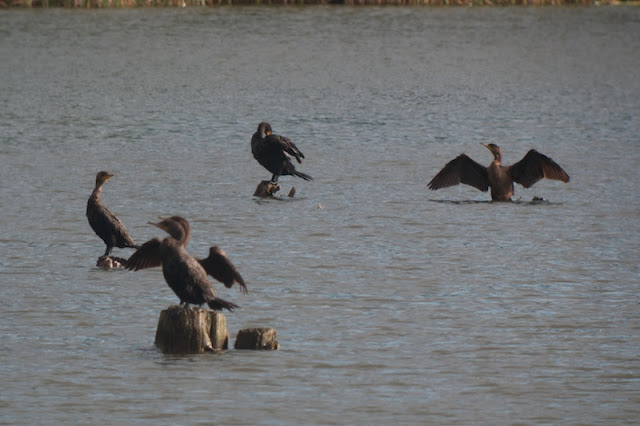While unsuccessfully trying to study this morning, I got distracted by an eBird email notifying me of an American Golden-Plover that was seen yesterday at Hespeler Mill Pond.
I decided to cancel my gull watching plans for later in the day and made my way to the pond. I had originally planned to go there this weekend but school commitments kept my time limited. Anyway, some things obviously take precedence over others ;)
At first there were no plovers of any kind to be seen. So I decided to make a CBC-style count out of all the birds. There was a surprising number of waterfowl - many more than at Laurel Creek and good numbers of Pectoral Sandpipers. It was a good opportunity to study the size differences between male and female Pectoral Sandpipers.
I must have thoroughly scanned the pond over 5 times while counting the various ducks without seeing and plovers - so I was a bit discouraged.
This Great Egret appeared at one point with the wingtag 34R.
There were plenty of Green-winged and Blue-winged Teals. Sometimes it was difficult to get a good look at the teal making it difficult to establish an identification. But knowing that the BW Teals have white at the base of the bill helps to distinguish the teal species.
This photo from Presqu'ile (2 weeks ago) shows the different facial markings. To the left are two Blue-winged Teals, and to the right is a GW Teal. The green on the wing isn't always so obvious - so knowing the other details can be helpful. Also note the different bill shape between the two species - not always easy to see!
Here's one of the Green-winged Teals from today - it, along with about 30 more, were probing in the mud like dowitchers:
At one point a Merlin flushed all the shorebirds and teal. The Golden-Plovers must have also been flushed up because not long after that I found them out in the open.
The supercilium (eyebrow) and cap-like appearance were immediately obvious:
And the long primary projection were also noticeable from the distance:
This Killdeer was notable for its extensive buffiness on the throat and supercilium. Is there any significance to this variation?
Here's a photo of the pond:
Only 3 Turkey Vultures today! That's a 99.7% decrease from yesterdays numbers :p









































